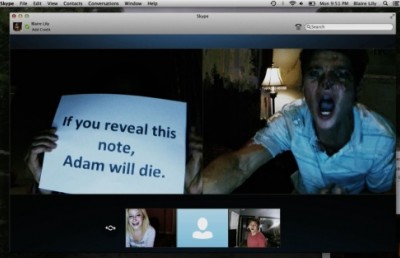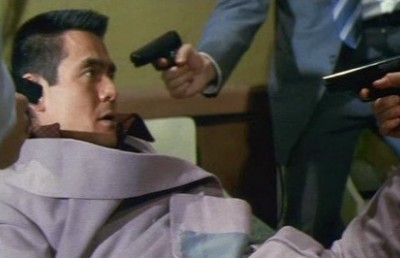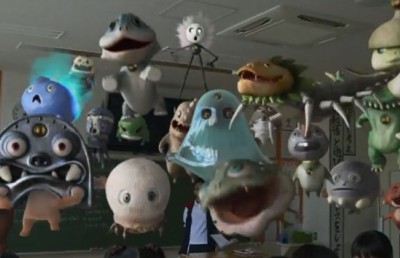Fantasia 2014: The Short of It
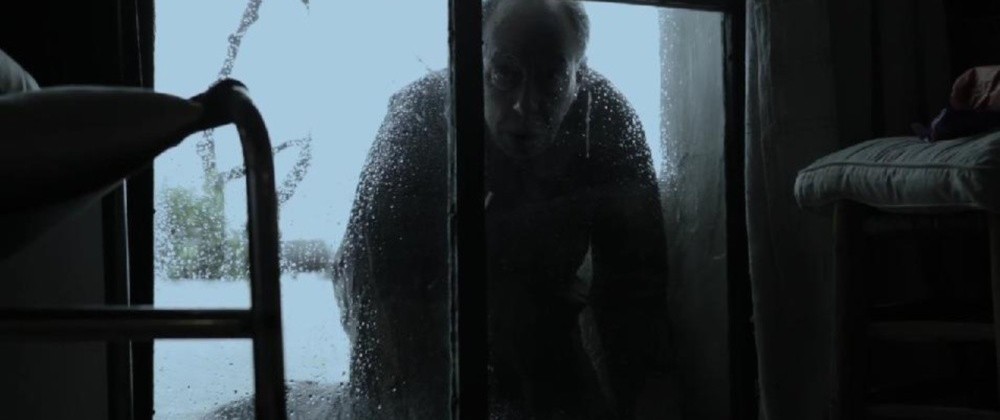
For the 2014 edition of Fantasia I was fortunate to serve on the short film Jury, so for my report I thought it would be appropriate if I write on some of the shorts I saw over the festival. As a preamble I should note that as Fantasia grows it is becoming hard to see all that you want or have the time for, but this is a welcome problem. The result is that, apart from my duties as short film juror, there were some wonderful highlights during 2014. Like the beguiling, progressive Danish coming of age female werewolf film, When Animals Dream (Jonas Arnby), the welcome return to the big screen of John McNaughton with his 35mm nervy The Harvest, the structurally complex, time shifting Venezuelan horror film The House at the end of Time (Alejandro Hidalgo), the opportunity to view a rare print of one of if not the first Quebec horror film Le diable et parmi nous (1972, Jean Beaudin); a fun filled midnight screening of Wolf Cop, local film collector/impresario Philippe Spurrell’s performance presentation of Dirty Movies: A History of Stag Movies, which included a screening of a 16mm print of Inserts, and last but not least, the opportunity to meet Tobe Hooper, recipient of a Lifetime Achievement Award, plus a screening of a digital restoration of The Texas Chainsaw Massacre. Below is a film by film breakdown of the top short films I saw in my capacity as short film juror.
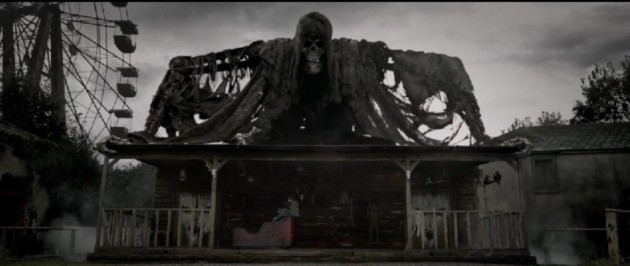
Ghost Train
Ghost Train (Lee Cronin, UK, 2014) is an impressive looking short, aided by mature performances and great sets, namely an abandoned amusement park ride. The film is told in flashback across a thirty year span into the past lives of three brothers, Michael, Peter and Sam, who go to an abandoned amusement park to relive a traumatic childhood event where one of the brothers was abandoned in the ride, trapped by a sinister or supernatural or malfunctioning ride mechanism. As noted, the film scores points through its great set. Is there anything creepier than an abandoned amusement park, with Texas Chainsaw like home furnishings at the entry point, a decapitated head hanging at the house’s porch area? As the film opens thirty something Michael and Peter are returning to the scene of a past event that has scarred them for life. As children they went to an abandoned haunted house and the consequence of their act led to the death (or kidnapping) of their younger brother Sam. During a flashback we learn that the two brothers did not pay the full toll for the ride, causing the creepy crypt keeper of the haunted house to trap the younger brother Sam in the ride house. They return to the site to revisit the traumatic space, and it is unchanged, as if time has stood still for them and the space. The ride is one pound, but they are short 52 pence. Sam provides the balance to make the fee. As they drop the coins into the slot the huge robotic skeleton slowly creeps into life. Peter is the drinker outcast, Michael the more composed, lesser scarred brother, married to a Finnish woman with kids, who tells Peter he is leaving Ireland for good. They return here every year to visit their guilt. We cut back to the past, and it is Peter who smashes the skull where the coins slot in. Michael had said that he put all the money into the slot but the truth revealed is that he did not. Michael is the more money conscious brother….so is this a sly critique of capitalism? Peter smashes the head thinking the machine ripped them off. When the skull cracks, Sam is trapped into the car and driven into the house, the door shuts close. Michael finally admits that it wasn’t Peter’s fault but his. He shows him the 50 pence he held back, still hanging onto it like a token reminder of his guilt. Thirty years late, Michael puts the 50 pence into the coin slot and the gate opens, followed by a seemingly empty car. But as the car moves out a nude, feral looking Sam rises from the car and walks toward Michael, who tries to make contact. Sam, who does not appear not to have aged, lashes out and slits Michael’s throat. In slow motion Sam begins to chase Peter. The camera cuts and is framed from inside Michael’s car; Peter is pulled below frame as a splash of blood hits the car window. Both brothers are dead. In EC Comics styled moral justice/vengeance is served. And the EC allusion is reinforced by the cryptkeeper. The film concludes with a final flashback of the three boys, with Sam and Michael deciding to go to the beach but Peter convincing them to go to the park by saying, “It’s a ghost train.” Hence he too bears some of the guilt, a guilt which lingers for thirty years and finally meets its retribution. Ghost Train is standard material, even predictable — although the turn to the supernatural could easily have been written to achieve a psychological affect— but handled in a satisfyingly effective manner.
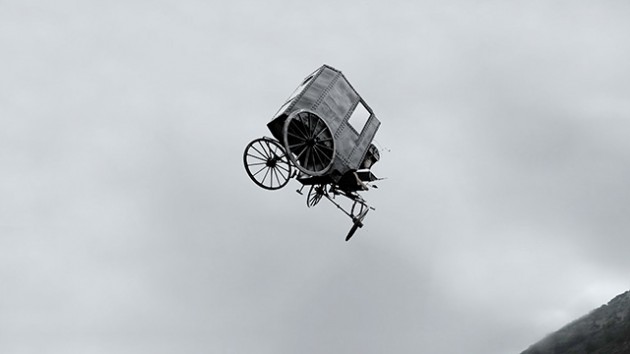
The Carriage: or Dracula & my Mother
The Carriage: or Dracula & my Mother (Ben Gordon, UK, 2014) opens with a Bavaesque carriage marooned against tree, setting up a retro Gothic ambience. A character named Ben discovers the coach is filled with earth, under which lies a coffin. The film is shot half as a first person mockumentary by the character Ben, framed within the 16 by 9 frame. The film’s main conceit is, “What happens when a Jew celebrates Christmas?” “Or when a vampire comes calling at your home?” The film negotiates successfully a tonal balance between camp and gothic. Wife and daughter leave Ben over an indiscretion when caring for the daughter. Odd acts begin to occur. A cat is found dead, bleeding. Ben finds a fallen old man next to the carriage. We see an insect with tentacles slither into the old man’s mouth. Ben is attacked by the old man and head butted into submission. Mother finds him as he slithers into the room. We see an old devil man staring, face at the window (recalling the hovering old man vampire in Dreyer’s Vampyr). Ben protects himself from the man beast with a Star of David. A truck takes the carriage away. As the carriage is crushed at the scrap yard, Ben seems to react. A bat crawls out of the carriage debris and flies away, landing on the side of another house. Suggesting the cycle will continue. The Carriage: or Dracula & my Mother scores points for its unique take on the vampire lore, and effective use of black and white cinematography that blends a modern attitude with a retro aesthetic.
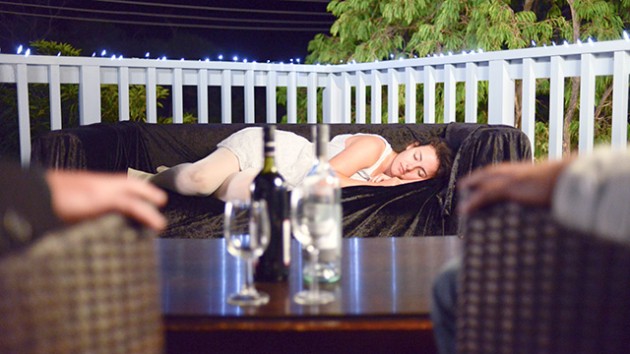
Black & White
Black & White (Richard Williamson, Australia, 2014) takes place entirely in one location: the veranda of an upscale house at night. Inside the house a wild party ensures. Outside on the veranda a disgruntled man, Guy, waits. He is visited by his date Lina, a lady wearing heavy mascara, who tries to convince him to return to the party. “Leave before 12 and you break the rules.” Snippets of the party can be seen inside through the window as silhouetted shadows. The main tension and impact of this short rests on the surprise twist based on what we expect the party to be about. We are given clues by the dialogue and actions of characters we encounter. For example, Lina goes back inside and another man dressed in black with heavy mascara, Julien, comes out from the party and begins to talk to Guy: “Hey I just had my cock sucked by a man…old.” A gorgeous woman appears asleep on a veranda couch. Guy is encouraged by a stranger to fondle her; he does and she screams, other people come out, while a woman in white (Hope) talks to him, “I had this dream….there was this face….” His date asks the woman in white, “would you like a hot dog?” “Come inside…you need a hot dog,” and they go inside. All of these bits of action and dialogue suggest we read the events inside as some type of sex party, a swinger party or a sexual swap meet. Guy confides with the man in black mascara about his past in a private school and being whipped for disciplinary purposes. The man in turn threatens him with an SM set up and how he is going to take him inside and whip him, but he retorts. “I’m going to enjoy you….I’m going to enjoy you the most.” We hear a yell from inside, and then the man in black reply, “oops…someone was lazy.” And then see a woman dressed in white come crashing through a glass door, all cut and bloodied. At this point the viewer begins to sense more than just a sex party. Our hunch is confirmed when a horde of black arts cultists come out onto the veranda. Lina utters the words, “White for whites,” which is like a spell that causes Guy to fall to the ground next to Hope; he is drugged, confused. Julien hovers over Guy, while Julien unbuttons his pants holding a knife in hand and repeats, “What did you say, just one cut….” The film ends on this portentous note. Will they castrate him? The short is driven by a strong script and strong performances and plays better the second time I saw it, where it was not relying on the twist which ends up being predictable, but on the determination of the players to remain vividly focused on being a singular part of the puzzle.
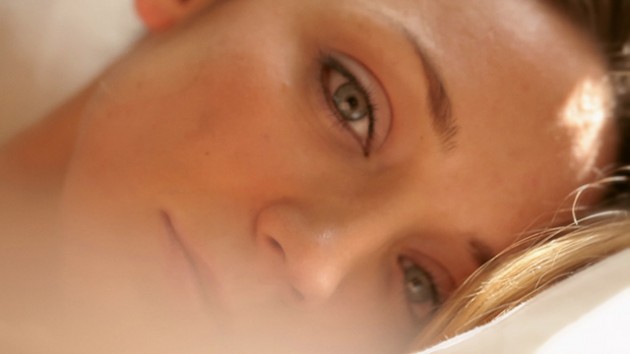
The Flames of My Love
The Flames of my Love (Jonathan Hludzinski, USA, 2014) looks at the problems of modern relationships, but treated in reverse, as a young woman is courted by two men. The film intercuts between the two men as if they were one. It starts at the end then moves back –literally by having the image rewind– and we get the woman playing off similar conversations between the two men, as if choosing between the two in her head. Outside of the discussion/date scenes there is a shot of one of the men, the lead, framed in a bathroom over lit in white light talking to the camera in first person. We assume it is the girl he is talking to but in the end it is revealed that the woman is in the tub, murdered by the man, wrapped up in plastic with her neck cut. The backward structure may be copied from Blue Valentine where we see a couple’s relationship start at the breakup then back in time to better times. Or, less likely, Jane Campion’s first TV feature, Two Friends, which treats a friendship between two teenage girls in reverse.
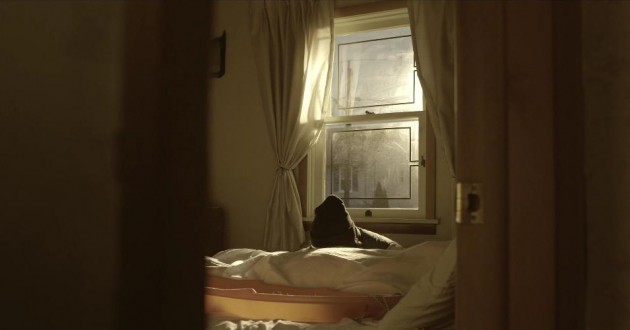
Former Things
Former Things (Adam Brown, USA, 2014) is another anti-zombie film, where the emphasis is on the ennui part of post-human life. There are no fast moving zombies, no action attacks, no music (just natural sounds) and no dialogue. A man, worse for wear, returns to an empty home, meanders about looking at things and then finds a corpse under a white sheet, with boils over its feet. Stylistically, there is a nice use of static long takes and framings that conceal and leave things to our imagination. For example, he finds a sled in the garage which he then uses to transport the corpse into the basement. As he tries to dispose of the corpse the shot is lit gorgeously, with camera outside the room looking in, and a window revealing a beautiful outdoor sunlight, only it feels artificial, with no sense of movement in the space, no wind, or change of light, as if to suggest that atmospheric life outside is ‘dead’. He washes the corpse and then waits. The framing cuts the corpse off at the waist, so then when the zombie gets up, with the white sheet covering the body, it recalls the iconic boat scene from the opening of Fulci’s classic Zombie. We see the legs move. He leaves to get a rifle and returns but doesn’t shoot the zombie. He leaves and returns with a hammer and then clubs him repeatedly in the head, then crouches over the corpse. We are never informed who this man-turned zombie is, but the care the man takes over the disposal of the corpse suggests it was someone close to him, perhaps his father. A simple film but with a plaintive mood that lifts the drama into melodrama.
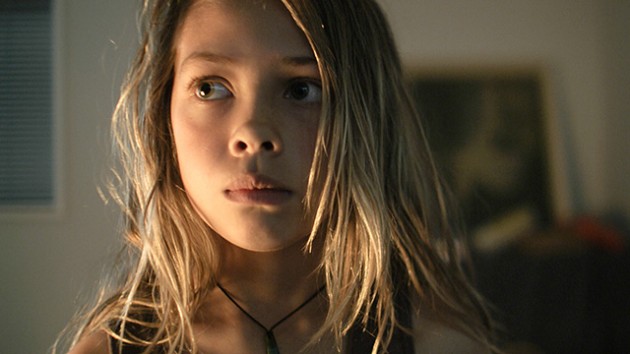
Here Be Monsters
Here Be Monsters (Nic Gorman, Paul Glubb, New Zealand) is vague about what has happened to the patriarch of a family —“Daddy is away protecting us. He is a soldier now”—but the title should give you a hint. The father returns home and tells his wife, “It happened.” She replies to the news by saying she’ll change into something nice, as if it is a call to celebrate. They cook a steak (clue?). They go to the beach and we see a man from afar approaching them slowly…. by now we realize we are in the land of zombies. They return home to spend a romantic evening, a bath, wine, then sex. The scene cuts to the daughter in living room. Father’s wrist watch alarm goes off, the daughter hears a gunshot, and walks, knife in hand, toward the bedroom. She opens the door and sees the father turned into a blood ravaged zombie, straddled over the mother, who must have shot and missed? Here Be Monsters makes a nice companion piece to Former Things by assuming the condition of being a zombie a natural occurrence, and focusing on the human elements, rather than the spectacular.
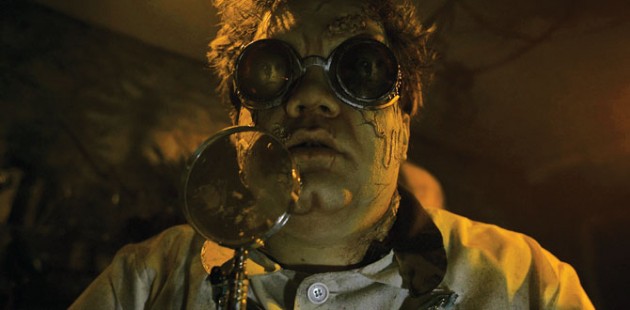
How to Make a Nightmare
How to Make a Nightmare (Noah Aust, USA, 2014) is another in a long line of films influenced by La Jetee. The opening image is a tight two-shot of a woman, Julia, sleeping in bed, having a nightmare, in VO we hear “My mother was a monster” [even this image suggests the scene of the sleeping woman in La Jetee). In hushed whispers we hear a scientist order, “Bring up the dream feed.” And, “Her subconscious is a mess.” The two scientists, Bill and George, wear dark goggles in a low tech laboratory, with wires, dust, broken artifacts, computer fans spewed everywhere. They are monitoring (or are within) the young woman’s subconscious life. A photo seems to trigger something, with a fast montage that cycles through variations on a young girl’s past (“It’s the kid stuff that gets to me”). The woman wakes up in a stupor, watching a mixture of news and her home movies on the TV. How to Make a Nightmare is a wild mix of live action with puppet animation, recalling Jan Svankmeyer. A central image becomes a motif: the woman framed in a round mirror on their desk. Once they start experimenting the film finds a funky groove, with a steady percussive beat and dance music driving rhythmic cutting. Along with La Jetee and Svankmeyer, the film draws possible influence from Brazil, late Guy Maddin, Shinya Tsukamoto’s Tetsuo, and perhaps Bladerunner. The film ends with one of the experimenters, Bill, dipping his face into a vat of her ‘innards’ which is represented by him as a small animated figure astral projecting over her ‘subconscious’ represented as a “Fantastic Voyage”-like human-as-seascape. George calls him and pulls him out of the vat, warning him, “Bill, it’s got to your brain.” Bill asks, “How are the girls in Japan.” After an answer, Bill, half drugged, says, “The future is bright,” the final words, which again recalls La Jetee. How to Make a Nightmare is very impressive on an imagistic standpoint, and has a great sound – image vertical montage.
Film can be viewed here:
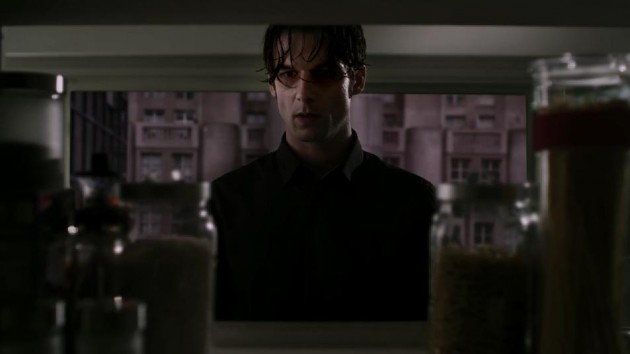
Jiminy
Jiminy (Arthur Molard, 2014, France) was the unanimous jury choice for the best short film at Fantasia 2014. When used well science fiction film can match the potential of science fiction literature to raise story and character to parable or social meaning. The great works of science fiction film and literature are about ideas which shape our identity as humans, socially or collectively. Great science fiction inspires us to think about how humanity shapes and is shaped by the universe around us. Space travel, time travel, colonialism, evolution, artificial intelligence, nature vs. culture, the value of science, the mind/body duality, free will, alien intelligence are just a handful of ideas that great science fiction films have explored: 2001: A Space Odyssey, Solaris, Planet of the Apes, Seconds, Silent Running, Godzilla, Forbidden Planet, The Amphibian Man, The Time Machine, War of the Worlds, The Day the Earth Stood Still, The Illustrated Man, Fahrenheit 451, Ikarie XB-1, A Clockwork Orange, The Clone Returns Home, Ex-Machina are just a few such films. I am not necessarily saying Jiminy slots into this hierarchy of achievement, but that it has something to say about human knowledge. And like great science fiction, the truth or the limits of what is possible is usually stretched to the arena of ‘what if’. What science fiction theorists call ‘extrapolation’: the art of taking what is real and bending it to the limits of credulity. We may not be able to do X now, but what if we could? There is no denying the impact that computers have had on humans up to now; in the domains of commerce, entertainment, medicine, technology, etc. In Jiminy the “what if” scenario takes the impact of the computer, or the age of the computer into generated brain control. What if our best thoughts, or indeed our thoughts, were controlled by something beyond us? Is it best to have free will, when the very nature of constant mind control has created a dependency on this ‘automatic’ mode living where everything is told to you? This scenario raises the same issue as A Clockwork Orange: is mind control achieved through intense state controlled behavioral modification preferable to a free will, even if that free will leads to anti-social conduct?
In the future society depicted in Jiminy humans have created a computer chip named Jiminy, a cricket that is placed inside bodies so that people can be controlled from without, removing the bother of having to make life’s many little choices. What happens in Jiminy is that without this auto choice pilot mode provided by the installed Jiminy, people are unable to choose, and become frozen in a state of indecision, leading to a condition called ‘donkey syndrome’ or Buridan’s ass, which is the inability to make a choice. Place a bag of oats and a pail of water equal distance from a thirsty, hungry donkey and it is unable to choose between the bag or pail and dies of hunger. A lady in a cafeteria line exemplifies this when she cannot choose between pie and cheese for desert and begins to cry. This recalls the opening of the film, where Nathanaël (Benjamin Brenière) is in his kitchen, framed from an impossible camera position inside the refrigerator, as he decides what to take out of the refrigerator. He makes a reasoned choice and takes out some eggs. This shot will be repeated, with a significant change, at the end. Nathanaël works as a Jiminy repair man, and is placed in a series of situations of constant moral choice. For example, the parents of an autistic boy say that the cricket does not work. He examines it and tells them that the boy’s anxiousness causes the safety mechanism in the chip to turn off (a feature which keeps the company from being liable if something happens to the person). They ask him to hack the cricket to turn off the safety mode, but Nathanaël’s ‘inner jiminy voice’ (spoken by another actor, Raphaël Almosni) advises him against it because he will make him potentially liable.
Nathanaël visits his wife who works at an institute for mentally ill people, people who do not have these jiminy crickets installed. One woman (the one unable to choose in the food line) had her chip removed because her husband hacked it and got his wife to do things against her wishes. Possible scenarios set up the moral dilemma of a control system which can be pirated and hacked, like any computer security system. Jiminy is enhanced by the appearance of great French actor Denis Lavant as Otto Hoffmann a schizophrenic at the institute who feels his cricket is betraying him, even though he does not have one. Otto places a drill to his own neck and Nathanaël manages to stop the suicide by lying, telling him his Jiminy was cracked and he put the safety mode back on. The white lie seems to work but only temporarily. A scene later Nathanaël is driving in his car and Otto appears in the back seat with a drill to Nathanaël’s neck; Otto is angry because he lied to him. Now Nathanael tells him the truth –Otto has no cricket and it is his inner voice talking to him. Otto drills into Nathanaël’s neck, but Nathanaël wakes up as if from a dream….only it becomes real when the scene reverts back to the opening, where we see Nathanaël in his “American Psycho” styled kitchen on automatic mode, with his Jiminy voice telling him what he should eat (don’t drink coffee because your blood pressure is high). Now he has a choice to make. He cracks the eggs on the counter, goes to open his fridge and stares at two food choices…..unable to decide. The scene cuts to Otto in his car, turning on the auto mode. The film ends with cross cuts between Nathanaël struggling with his dress and food choices and Otto, eyes closed, trusting his Jiminy but getting into a car crash (sounds of the crash are heard off-screen). Jiminy plays out well its speculative premise about the perils of technology and free will, and our growing dependency on technology, especially social media and communication technologies.
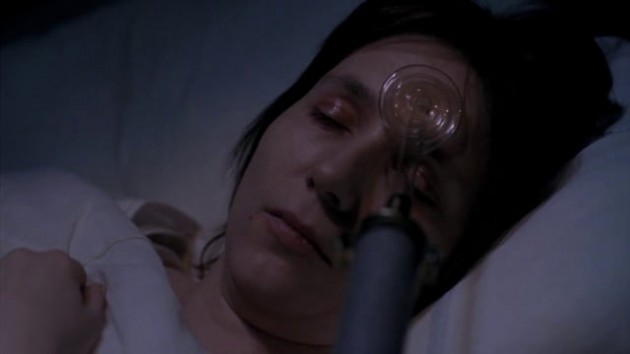
Robata
Robota (David Braun, US, Spain, Czech Rep, 2013) touches on a similar thematic as Jiminy, artificially conditioned humans, while mixing live action and animation, like How to Make a Nightmare. A woman is linked up to a robot that prepares her food based on what the robot reads from her brain waves. The mixture of live action and animation is used to represent the woman’s inner thoughts as read by the robot. She feeds her fish in the aquarium. The first meal seems eatable, but the meals become progressively worse. Robota is like a science fiction version of Groundhog Day. The middle and final animation sequences are very playful and joyful. The robot seems to short circuit and the result is a hole in the fabric of her wall, exposing her to the universe beyond her artificially generated universe.
Robota trailer:
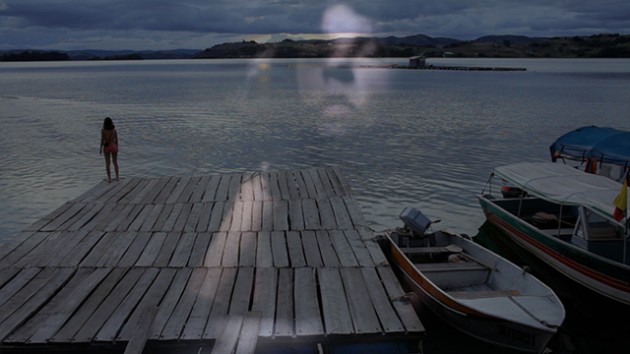
Sea Child
In Sea Child (Marina Shron, Columbia/US, 2013) a teenage girl, Lila, mourns the death (possibly by suicide) of her father, while the Mother tries to soldier on. Sea Child navigates an aesthetic fine line between film and digital technology, aiming for a mesmeric celluloid style through digital cinema. The film blends the use of chime music, superimpositions, slow motion and digital artifacts to give it an analog/film feel. In some of the image collages we see sprockets. For a short film it is very ambitious with its underwater shooting. Lila leaves her mother on beach to go to the pier. She imagines her father alive in the sea. A tourist, speaking English, docks after a fishing trip. They make small talk. Lila has her father’s old still camera. She jumps into water and the tourist jumps in after, although Lila does not appear to want to be saved. In slow motion we see them perform an underwater dance. Lila seems to send the tourist above water, while she remains underwater, seemingly able to breathe under water. It ends with a scene of a young man walking on the beach toward the mother; they kiss. Is this when they first met (in the opening we hear daughter’s VO say they met at this lake). Or does Lila die? And this is her posthumous memory of when her parents first met?
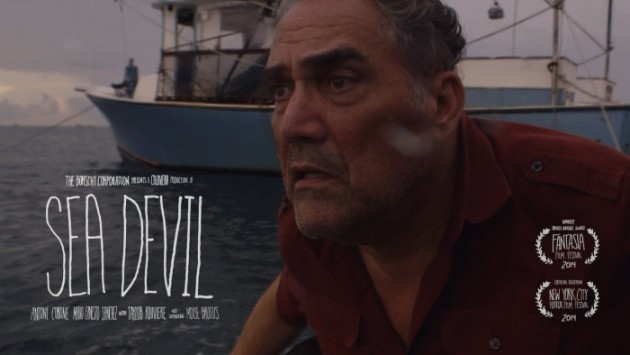
Sea Devil
Sea Devil (Dean C. Marcial and Brett Potter, Australia) is based on a true story of a fishing boat that returned unmanned to shore on June 21, 2012 into the Biscayne Bay, Miami; the crew was never found. It flamboyantly dramatizes what may have happened to the small crew, the fisher men and an Aussie man and his daughter who join them onboard. After a stretch without a catch, something bites, but it is no regular catch: they pull up a gruesome black amputee, his body filled with gooey maggots. He is alive, a sort of sea devil, with one arm, no legs. He strikes fear by ‘contaminating’ the fishermen, telling him “You are now me”; moments later he is staring blankly and falls off the boat into the water. The next morning the man and daughter leave the boat on a raft, only to be confronted by a huge mass of industrial pollution rising out of the sea. Though it takes enormous liberty with whatever the truth may have been, the film is very unnerving, aided greatly by being shot on live waters. The story’s mystery is self-contained in the film’s structure, bookended by phantom point of view shots of the unmanned ship floating into the Bay. I would guess that with its atmospheric lighting, moody sounds, scenes of fish being trawled in, the shots of downtime in the kitchen area, and the sublime nature, the film was heavily influenced by the experimental documentary Leviathan (2012, Lucien Castaing-Taylor, Verena Paravel).



